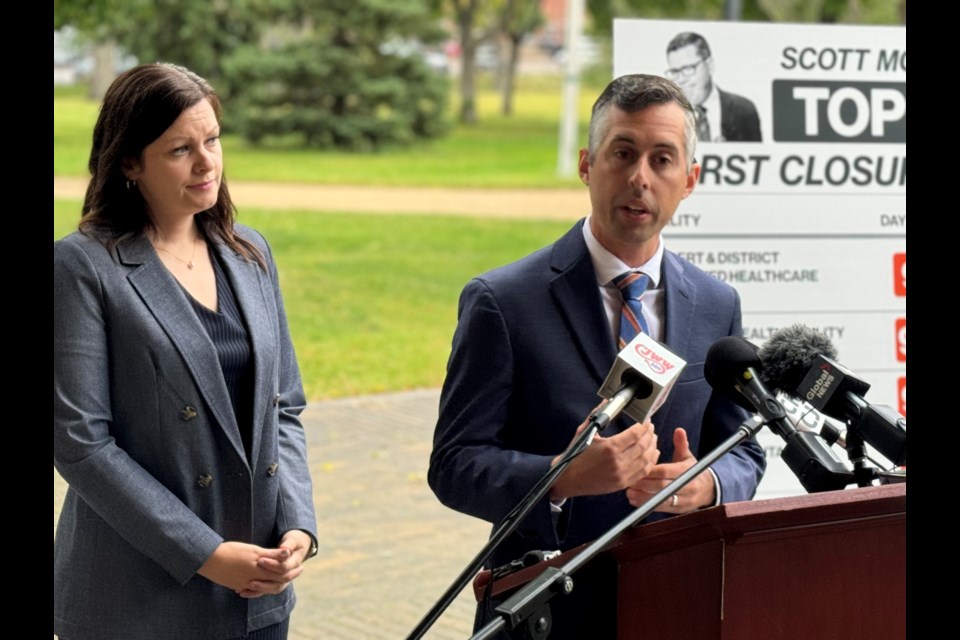MOOSE JAW - Moose Jaw’s hospital experienced nearly 20 disruptions during the past five years that reduced services by over 300 days, which the NDP says shows how badly the provincial government has failed residents.
The provincial Opposition released data recently that it acquired through a freedom of information request.
The overall numbers showed that between Aug. 1, 2019, and May 10, 2024, there were 206,712 hours, or 8,613 days, when 58 hospitals and health centres experienced 1,305 disruptions — or “blackouts” — with their services.
Emergency stabilization services had the most disruptions at 506 incidents, leading to 3,156 days of total disruptions. Next was basic radiography and laboratory services with 331 incidents, leading to 2,203 days of total disruptions.
The data also showed that overall, across the province, last year, 455 disruption incidents were reported, followed by 399 incidents in 2022, 163 incidents in 2021, and 45 incidents in 2019 between August and December.
Between January and May of this year, there have been 122 disruption incidents.
The Herbert & District Integrated Healthcare Facility had the most total time with disruptions, at 971 days, due to 59 total disruption incidents, the data showed.
Northwest Health Facility in Meadow Lake had the greatest number of overall disruptions, at 159 incidents, which led to 936 days of total disruptions.
Moose Jaw’s Dr. F. H. Wigmore Regional Hospital was the seventh-most affected hospital or health-care centre in the province. Data shows that, during the past five years, it had 17 total disruption incidents that led to 303 days of total disruptions.
The most disruptions occurred in basic radiography and laboratory services between Nov. 25, 2020, and June 29, 2021, with 216 total days of disruptions, the data showed. Meanwhile, this area experienced 231 total days of disruptions during the past five years.
The second-most affected area was emergency stabilization services between July 11, 2020, and Aug. 31, 2020, with 51 total days of disruptions.
Other areas affected included obstetrics care, bariatric services, CT scans, X-rays, MRIs and more.
NDP comments
“We see … certainly some significant disruptions at the hospital there in Moose Jaw … so certainly concerning,” Jared Clarke, the NDP’s critic for rural and remote health, told MooseJawToday.com by phone.
One issue driving these disruptions is the lack of health-care professionals to staff buildings, he continued. During the last six years, there has been a 21-per-cent decline in people working in rural and remote places, from doctors to nurses to occupational therapists.
Many professionals have left the industry because of the Sask. Party government’s poor leadership, with those vacancies straining the system and leaving residents without services, he pointed out.
“I think these numbers really support the stories that we have heard from health-care professionals across the province — and patients … ,” Clarke added. “These numbers are really talking about health care not being there for Saskatchewan people when they need it.”
The Sask. Party has been in power for 17 years and health-care workers have been raising concerns for years now, while the NDP has amplified those voices, said Vicki Mowat, the NDP’s health critic.
“What we’ve been hearing from health-care workers is the government just isn’t listening to them, isn’t respecting them and isn’t providing the changes they need to see,” she remarked.
Retention in one place will look different in another because of various factors, so the NDP has been encouraging the province to return local voices to health care discussions, Mowatt said.
She noted that one suggested change comes from the Saskatchewan Union of Nurses (SUN), which wants a nursing task force created to focus on retention and keep workers in the industry.
“All of this falls directly at the feet of Scott Moe and the Sask. Party … and this is the responsibility of this government to fix,” Mowat added. “This is the birthplace of Medicare; people deserve so much better than the care they’re getting here.”
Province’s response
The province responded to the NDP’s criticisms in an email to MooseJawToday.com.
“Filling the vacant positions required to stabilize and strengthen health-care services is a high priority for our government,” the email said. “Thousands of vacant positions have been successfully filled since we put forward our Health Human Resources Action Plan in fall 2022, with significant results for rural and regional communities.”
The province then listed seven communities — including Moose Jaw — as examples where it had successfully hired nurses, care assistants and lab and scan technicians during the past two years. Overall, it noted that it had recruited more than 1,700 health-care professionals in rural and regional areas during that time.
“We now have over 1,000 more physicians practising in the province than when we were first given the honour of forming government in 2007, a 62-per-cent increase, which far outpaces the population growth rate of 23 per cent,” the province said.
“Our record is a stark contrast to the NDP, who closed 52 rural hospitals, and in their last five years in government, ran 173 physicians and 450 nurses out of the province.”




